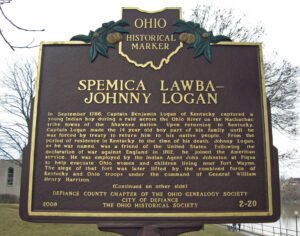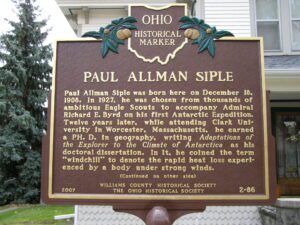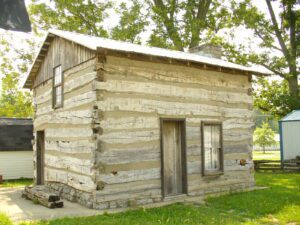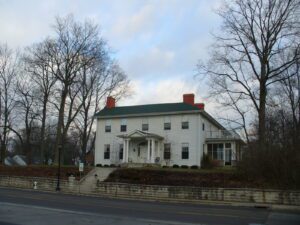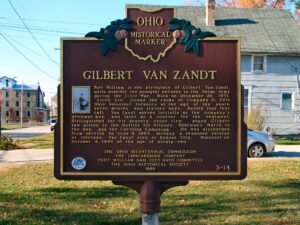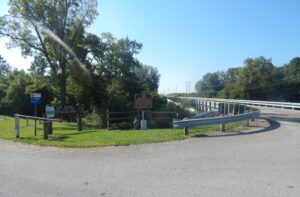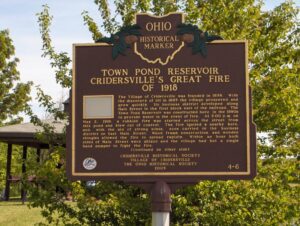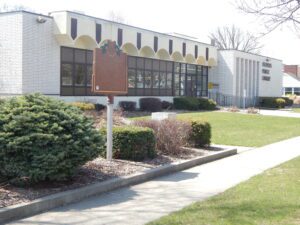, OH
In September 1786, Captain Benjamin Logan of Kentucky captured a young Indian boy during a raid across the Ohio River on the Machachac tribe towns of the Shawnee nation. Upon returning to Kentucky, Captain Logan made the 14 year old boy part of his family until he was forced by treaty to return him to his native people. From the period of residence in Kentucky to the time of his death, Johnny Logan, as he was named, was a friend of the United States. Following the declaration of war against England in 1812, he joined the American service. He was employed by the Indian Agent John Johnston at Piqua to help evacuate Ohio women and children living near Fort Wayne. The siege of that fort was later lifted by the combined force of Kentucky and Ohio troops under the command of General William Henry Harrison. [continued on other side]
, OH
Paul Allman Siple was born here on December 18, 1908. In 1927, he was chosen from thousands of ambitious Eagle Scouts to accompany Admiral Richard E. Byrd on his first Antarctic Expedition. Twelve years later, while attending Clark University in Worcester, Massachusetts, he earned a PH.D. in geography, writing Adaptations of the Explorer to the Climate of Antarctica as his doctoral dissertation. In it, he coined the term “windchill” to denote the rapid heat loss experienced by a body under strong winds. [continued on other side]
, OH
This house originally stood at Logan’s Gap, Union Township. By tradition, it was constructed in 1793 by Indian scouts William Dixon and Cornelius Washburn who became residents of Brown County. Dixon lived in this house until 1800.
, OH
One of the most effective political orators of his era, Tom Corwin (nicknamed “the Wagon Boy” for his War of 1812 service) resided here from 1839 until his death. A Whig stump speaker known for his wit and eloquence, he was elected governor of Ohio in 1840 and campaigned for William Henry Harrison in his presidential victory that year. Corwin served six terms in Congress and one in the Senate, where he spoke out against the Mexican War in 1847. He also served as secretary of the treasury in the Fillmore administration and as President Lincoln’s minister to Mexico. Built and first occupied by Corwin’s brother-in-law Phineas Ross in 1818, the Corwin House is representative of Federal-style architecture of this period.
, OH
Port William is the birthplace of Gilbert Van Zandt, quite possibly the youngest enlistee in the Union Army during the Civil War. Born on December 20, 1851, “Little Gib” joined the ranks of Company D, 79th Ohio Volunteer Infantry at the age of ten years, seven months, and sixteen days. Barely four feet tall, Van Zandt served initially as the company’s drummer boy, and later as a courier for the regiment. Distinguished for his bravery under fire, young Gilbert saw action in the battles for Atlanta, Sherman’s March to the Sea, and the Carolina Campaign. He was discharged from service on June 9, 1865, already a seasoned veteran at thirteen. Van Zandt died in Kansas City, Missouri on October 4, 1944 at the age of ninety-two.
, OH
After American militia troops forcibly ended the 1812 siege of Fort Wayne, General James Winchester’s Army of the Northwest marched down the north side of the Miami [Maumee] River to stop or retard advancing British troops sent to aid in the siege of Fort Wayne. After three days of difficult march, Ensign James Liggett of the 17th Regiment, volunteered to lead a group of four spies or scouts to the site of the old Fort Defiance. Liggett’s small force was surprised and killed on or about September 25 near here. The Americans tried twice to recover the bodies, but met with ambush from hostile Native Americans sympathetic to the British. Their bodies were finally recovered and buried in a common grave. Besides Liggett, they included Wyatt Stepp, Guy Hinton, William Bevis, and Nathaniel Mitchell of Woodford County, Kentucky, all of Captain McCracken’s Company, 1st Rifle Regiment, Kentucky Volunteer Militia.
, OH
The Village of Cridersville was founded in 1856. With the discovery of oil in 1885 the village prospered and grew quickly. Its business district developed along Main Street in the first block east of the railroad. The Town Pond Reservoir was constructed here in the 1890s to provide water in the event of fire. At 3:00 p.m. on May 2, 1918, a rubbish fire was started across the street from this pond and blew out of control. The fire ignited a nearby barn, and, with the aid of strong winds, soon carried to the business district on East Main Street. Wood frame construction and wooden shingles allowed the fire to spread rapidly. Within an hour both sides of Main Street were ablaze and the village had but a single hand pumper to fight the fire. (continued on other side)
, OH
A farm boy with a tenth grade education, Leslie Peltier, born near Delphos in 1900, achieved fame as one of the most famous astronomers of the twentieth century. In 1916, he raised $18 dollars by picking 900 quarts of strawberries on his father’s farm in order to purchase his first telescope. His stargazing abilities led Harvard Observatory’s Dr. Harlow Shapley to proclaim him “the world’s greatest non-professional astronomer.” During his 65 years of stargazing, Leslie Peltier discovered 12 comets and two novae and made 132,000 variable star observations. Peltier made his discoveries on his homemade “merry-go-round” observatory that rotated on a child’s merry-go-round track and housed the optics from a 6-inch, f/8 telescope on loan from Princeton University. To recognize his achievements, the Astronomical League created the annual Leslie C. Peltier Award in 1980 to recognize an amateur astronomer who contributed to astronomy observations of lasting significance.


